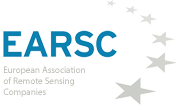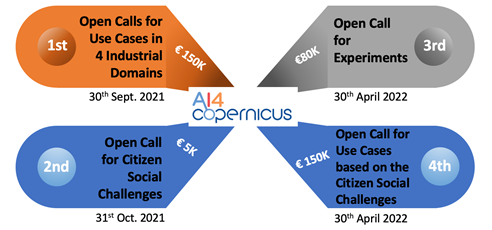Celebrating our first anniversary we returned to the evidently popular subject of the use of AI technology for Earth Observations. In a previous EOcafe on the 4th February, we heard from the AI4EO project which is one of many springing up with different sponsors at European and national levels to promote this synergy between technologies. There are many initiatives[1] and one of our aims in EOcafe is to try to help clarify this somewhat complicated landscape.
Our focus this week was the initiative AI4Copernicus which is a newly launched project under Horizon 2020. The project manager, Vangelis Karkaletsis (Director at the Institute for Informatics and Telecommunications at Demokritos), explained the structure of the project, its partners and the links with some of the other initiatives especially the DIAS and a second H2020 project, AI4EU. AI4EU involves partners from research and industry aiming to deliver research and innovation in AI. It is a broad programme spanning many different sectors to which, AI4Copernicus seeks to add EO services. One key deliverable is the provision of a catalogue of AI resources and tools, an experimentation platform, a content manager system for AI events and open calls. AI4Copernicus partners include companies involved in 3 of the DIAS platforms, public institutions and research institutions to enable AI and EO innovation.
A key goal of the project is to provide a bridge between Copernicus as an EU flagship and its data and services available through the 3 DIAS and the resources available under the AI4EU. As expressed by Vangelis, to make the AI4EU AI-on-demand platform, the platform of choice for users of Copernicus data along the value chain (scientists, SMEs, non-tech sector). The Dias’ Creodias, Mundi and Wekeo are all represented amongst the project partners. AI4Copernicus will provide support to teams creating new services which will be installed on at least one of the 3 DIAS.
Xenia Ziouvelou, (Research Associate at NCSR Demokritos & Lead of the AI4Copernicus Open Calls) explained how the project will launch calls for new services integrating EO data, and AI technologies. An important contribution of this project, as Xenia mentioned, is the possible creation of new ecosystems as a result of by bringing together these communities, including technology advancements, new markets, at innovation and industry levels.
Xenia explained that there will be 4 rounds of calls, the 1st call will be for use cases in four industrial domains in the areas of energy, health, security, and agriculture domains. The 2nd call is to be focused on citizen social challenges, the 3rd call for experiments and the last call on use cases based on the citizen social challenges. AI4EU will provide cloud infrastructure for the successful applicants and also create instances inside the DIAS platforms to enable the successful candidates with data sets access, cloud, and services among some tools. Regarding the financing, Xenia mentioned for the first round of calls it is provided a 100% funding for a two or more partner consortium of up to 150,000 EUR per project. Important to note that the consortium must have a partner with at least some expertise on AI to assure the running of the project.
Responding to a suggestion from Alberto MenVangelis agreed that this is a good example of a new tool that could be installed on a DIAS platform and made available through AI4EU (or vice versa). This could then be used by many new services as a building block. He mentioned as an example the existence to populate tools demand applied to this case could be the use of tools of the AIEnergy project, which is one of the ‘sister’ projects and how its datasets can be used as well for AI4Copernicus.
Geoff asked about the sustainability of the AI4EU platform as the project ends in less than 9 months time (end 2021)? How can challenge winners be confident that effort invested in installing their applications on either DIAS or AI4EU will still be supported in 1- or 2-years’ time? Vangelis explained that this is currently being studied but that the leader of AI4EU, Thales, is committed to keeping the platform running. The AI4Copernicus project will contribute to the sustainability by enriching the set of tools which are available. Research projects are expected to contribute more tools which will extend the AI4EU platform and ensure it is used by other communities. In terms of the funding to secure this, it is not yet clear, but it is foreseen to establish a foundation and more details on this will be worked out in the next few months.
Four partners in the project are potential users of new services. Richard Hall (Equinor - a leading energy company) outlined some of the questions which he would like to be addressed through challenges and that there are links between the 4 sectors to be addressed: For instance,
- Energy and health, how do the activities of energy companies’ impact on the health of a city?
- Energy and security, how much energy can Europe produce? Where is it needed or will be needed in 50 years time?
- How can EO and meteorological data be used to optimise the cleaning of solar panels from dust and particles gathering on them?
Vangelis confirmed that questions like these will be included in the calls as a guide to those responding.
Vasilis Baousis from ECMWF introduced his view of the project with both the use of data from CAMS and the use of the DIAS WEKEO where ECMWF is a partner with Eumetsat and Mercator. Vasilis also cited Destination Earth as another future resource and source of tools and data. Vangelis also pointed out the link with the AI4EO project through ECMWF which is driving their first challenge launched by this other project.
Michele Lazzarini from SatCen mentions that security is an important domain with possible applications connected to other sectors. For this, SatCen is currently drafting its calls based on security needs and the interaction with other sectors (e.g. climate).
Vangelis summarised with a reminder that funds are available! The first calls will be launched in June/July with a deadline to respond by end-September. The 6 selected projects, each for up to €150k, will be launched in January 2022. Good luck to everyone!
Geoff Sawyer & Sandra Cabrera Alvarado
[1] AI4EO (ESA), AI4EO (EC), AI4EO (DLR), AI4EU (EC), AI4Copernicus (EC), AI4Copernicus (Copernicus Relay in Wallonia and Luxemburg), AI4GEO (CNES) and many more.


This page has no comments.